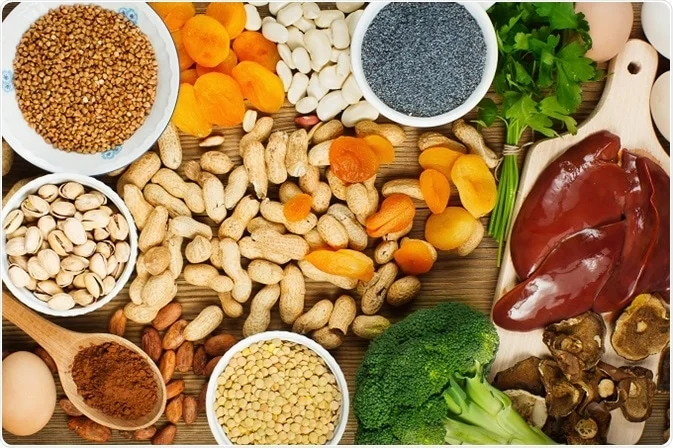The Recommended Dietary Allowance (RDA) for adults 19–50 years old is 8 mg daily for men, 18 mg for women, 27 mg for pregnancy, and 9 mg for lactation.

Iron is an essential mineral that helps maintain healthy blood. A lack of iron results in iron-deficiency anaemia, the most common nutritional deficiency worldwide, causing extreme fatigue, weakness, confusion, loss of concentration, sensitivity to cold, shortness of breath, rapid heartbeat, pale skin, hair loss, brittle nails, and lightheadedness.
It affects all ages, with children, women who are pregnant or menstruating, and people receiving kidney dialysis among those at highest risk for this condition.
Iron is a major component of haemoglobin, a type of protein in red blood cells that carries oxygen from your lungs to all parts of the body. Without enough iron, there aren’t enough red blood cells to transport oxygen, which leads to fatigue.
Iron is also part of myoglobin, a protein that carries and stores oxygen specifically in muscle tissues. Iron is important for healthy brain development and growth in children and for the normal production and function of various cells and hormones.
Iron, the mineral from food comes in two forms: heme and non-heme. Meats, poultry, and seafood are richest in iron. Fortified grains, nuts, seeds, legumes, and leafy vegetables contain non-heme iron. In the U.S., many breads, cereals, and infant formulas are fortified with iron.
Heme iron is better absorbed by the body than non-heme iron. Certain factors can improve or inhibit the absorption of non-heme iron. Vitamin C and heme iron taken at the same meal can improve the absorption of non-heme iron. Bran fibre, large amounts of calcium, particularly from supplements, and plant substances like phytates and tannins can inhibit the absorption of non-heme iron.
Iron is stored in the body as ferritin (in the liver, spleen, muscle tissue, and bone marrow) and is delivered throughout the body by transferrin (a protein in the blood that binds to iron). A doctor may sometimes check the blood levels of these two components if anaemia is suspected.
The Recommended Dietary Allowance (RDA) for adults 19–50 years old is 8 mg daily for men, 18 mg for women, 27 mg for pregnancy, and 9 mg for lactation.
The higher amounts in women and during pregnancy are due to blood loss through menstruation and the rapid growth of the foetus, which requires extra blood circulation during pregnancy. Adolescents 14–18 years old actively growing also need higher iron: 11 mg for boys, 15 mg for girls, 27 mg for pregnancy, and 10 mg for lactation.
The RDA for women 51 and older drops to 8 mg with the assumption that cessation of menstruation has occurred with menopause. It may be noted that menopause occurs later for some women, so they should continue to follow the RDA for younger women until menopause is confirmed.
Iron bioavailability is determined almost totally by the efficiency of iron absorption in the intestine. Total iron intake, composition of the diet, and iron status of the individual consuming the diet all play a role in determining the amount of iron absorbed. Iron species in foods may be broadly grouped as either heme or non-heme.
It occurs primarily as haemoglobin or myoglobin and is thus found exclusively in meat, poultry, and fish. Virtually all the iron, the mineral in plant foods and approximately 40–60% of the iron in animal tissues is non-heme iron.
Several enhancers and inhibitors or non-heme iron absorption have been identified. Enhancers include meat, poultry, fish, ascorbic acid, EDTA, and inhibitors such as polyphenolics (tannin in tea, legumes, and sorghum), phytates (present in legumes and whole grain cereals), some plant proteins (especially legume proteins), calcium, and phosphates.
Like oxalate, which inhibits calcium absorption, phytic acid inhibits iron, zinc, and calcium absorption. Oxidants inhibit the absorption of iron. Reductants such as ascorbic acid enhance the absorption of iron.
A high concentration of one mineral in the diet may inhibit the absorption of other minerals, such as calcium, which inhibits iron absorption, iron, which inhibits zinc absorption, and lead, which inhibits iron absorption.
Sometimes malabsorption disorders may reduce the absorption of minerals. With age, absorption efficiencies may decline in the elderly. The overall bioavailability of iron in a diet is determined by the complex interactions of enhancers and inhibitors.
As per the WHO, Anaemia is recognised as a global public health problem. Particularly in developing countries like India, the prevalence of anaemia among adolescents varies from 10 to 20%, according to a recent study. Anaemia is associated with poor cognitive and motor development in children and work capacity in adults, influencing the country’s economic development.
The following interventions or strategies need to be addressed in any programme aimed at improving general well-being, especially iron status. Multiple factors to include in these strategies are elucidated below.
Poverty reduction, ensuring food security, Improvement in antenatal services, creating an awareness programme among mothers, Improvement of accessibility to diversified diets; Promotion of better care and feeding practises, i.e., exclusive breastfeeding; Food fortification and food-based approaches; Prevention and treatment of infectious diseases such as malaria, tuberculosis, etc. Promoting safe water, sanitation, and hygiene (WASH), Parasitic disease control programmes, especially for manifestations of helminths, Integration with other micronutrient control programmes, Monitoring and evaluation of programmes, Implementing innovative programmes, Intersectoral coordination, Advocacy and social communication, Strengthening the surveillance system and Continuous monitoring of new research and its incorporation into the programme
According to Nutrition International, over 79,000 pregnant Pakistani women were reached with iron and folic acid supplementation and nutrition education in the context of COVID-19.